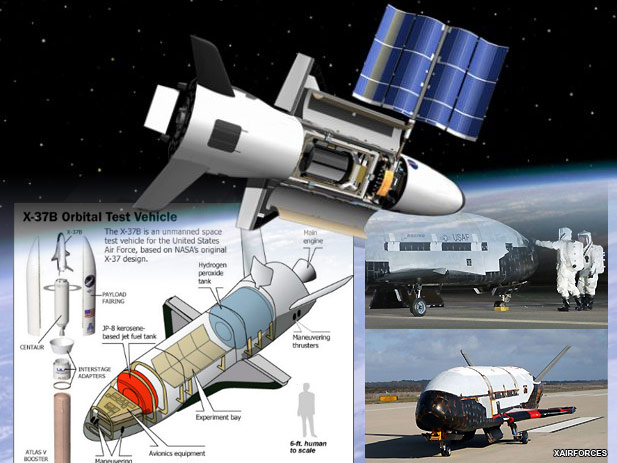
Inside the Air Force's Secret Mission X-37B Space Plane

After nearly seven months of flight, the U.S. Air Force's latest X-37 robotic space plane is nearing a milestone in its secret mission in Earth orbit as it chalks up mileage and operational experience.
As of last week, the reusable X-37B space plane had been in orbit for more than 206 days, two months shy of its 270-day mission design lifetime. The spacecraft, which looks like a miniature space shuttle, launched on its clandestine mission on March 5 from Cape Canaveral, Fla.
The space plane is the second X-37B spacecraft built for the Air Force by Boeing's Phantom Works and carries the name Orbital Test Vehicle 2, or OTV-2.
The X-37B — like the now-retired NASA space shuttles — is capable of returning experiments to Earth for further inspection and analysis, as well as re-flight of equipment. [Photos: Air Force's 2nd Secret X-37B Mission]
Extended flight possible
"On-orbit experimentation is continuing, though we cannot predict accurately when that will be complete," said Air Force Lt. Col. Tom McIntyre, the X-37 systems program director. “We are learning new things about the vehicle every day, which makes the mission a very dynamic process."
McIntyre told SPACE.com that X-37B controllers initially planned a nine-month mission "but will try to extend it as circumstances allow." Doing so would provide program officials with additional experimentation opportunities "and allow us to extract the maximum value out of the mission," he said. [Infographic: Inside the X-37B Space Plane]
The X-37B is being operated under the direction of Air Force Space Command's 3rd Space Experimentation Squadron, a space control unit located at Schriever Air Force Base in Colorado.
These hush-hush missions fall under the auspices of the Air Force Rapid Capabilities Office.
Mystery mission
The X-37B spacecraft is about 29 feet (8.8 meters) long and 15 feet (4.5 meters) wide. It has a payload bay about the size of a pickup truck bed. Thanks to a deployable solar array power system, the vehicle can fly a mission for up to 270 days, project officials have said in the past.
What exactly the vehicle does while circling the Earth is a mystery, since the spacecraft's cargo is consistently classified. Payloads may well involve high-tech testing of photoreconnaissance gear, but other hardware for intelligence-gathering could be onboard.
The first flight of an X-37B space plane, in 2010, entailed a mission that lasted 225 days. The spacecraft was lofted on April 22 and landed on Dec. 3, gliding onto a specially prepared runway at Vandenberg Air Force Base in California.
When this second X-37B mission draws to a close, a "do-it-itself" guided entry and wheels-down runway landing and similar to the end of the first mission are expected at Vandenberg Air Force Base, with neighboring Edwards Air Force Base as an alternate site.
If the incoming space plane strays off its auto-pilot trajectory zooming in over the Pacific Ocean, the craft is outfitted with a destruct mechanism.
Future X-37B Missions?
Meanwhile, Boeing has begun to look at derivatives of their X-37B Orbital Test Vehicle — including flying cargo and crew to the International Space Station.
Speaking this week at the Space 2011 conference —organized by the American Institute of Aeronautics and Astronautics (AIAA) and held in Long Beach, Calif. —Arthur Grantz of Boeing Space and Intelligence Systems sketched out a host of future uses for the space plane design.
For one, the X-37B, as is, can be flown to the space station and dock to the facility's common berthing mechanism. No new technology is required for X-37B to supply cargo services to the ISS, Grantz said. Also, an X-37C winged vehicle has been scoped out, a craft that would ride atop an Atlas 5 in un-shrouded mode.
The Boeing roadmap, Grantz added, also envisions a larger derivative of the X-37B space plane, one that can carry up to seven astronauts, as well as tote into Earth orbit a mix of pressurized and unpressurized cargo.
Source: By Leonard David - October 04, 2011 - www.space.com - http://www.foxnews.com
Photo: NASA's Marshall Space Flight Center image shows on-orbit functions for the reusable X-37 space plane, now under the wing of the U.S. Air Force. (FOX News Network)
The U.S. Air Force launched the robotic X-37B space plane in early 2010 on a space mission that remains a secret -- even after the craft touched ground 225 days later at Vandenberg Air Force Base. In early 2011, the ship took off again on its latest mission. (Boeing)
(5.10.2011)
|